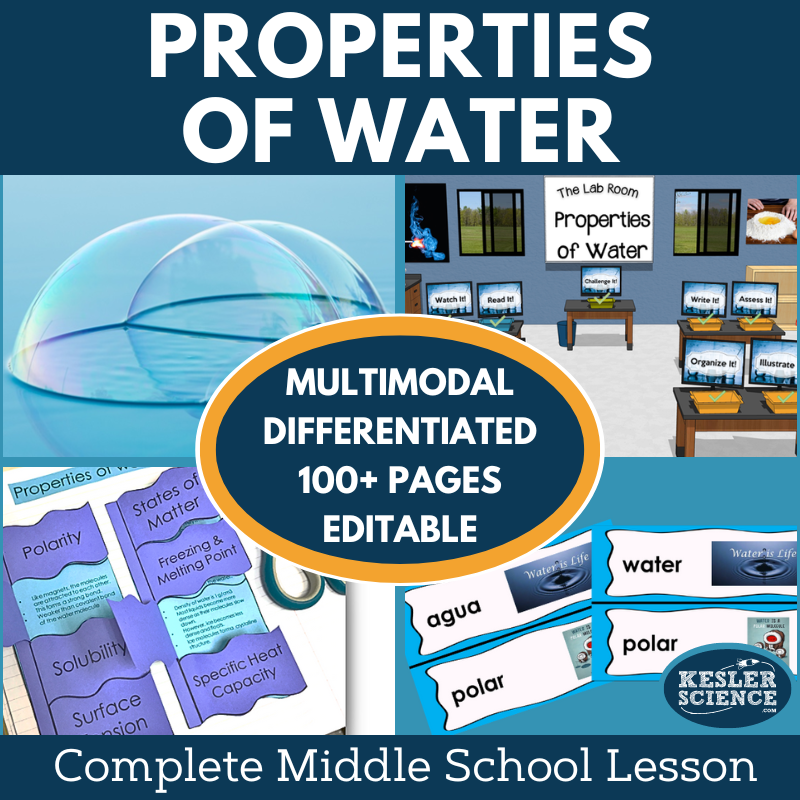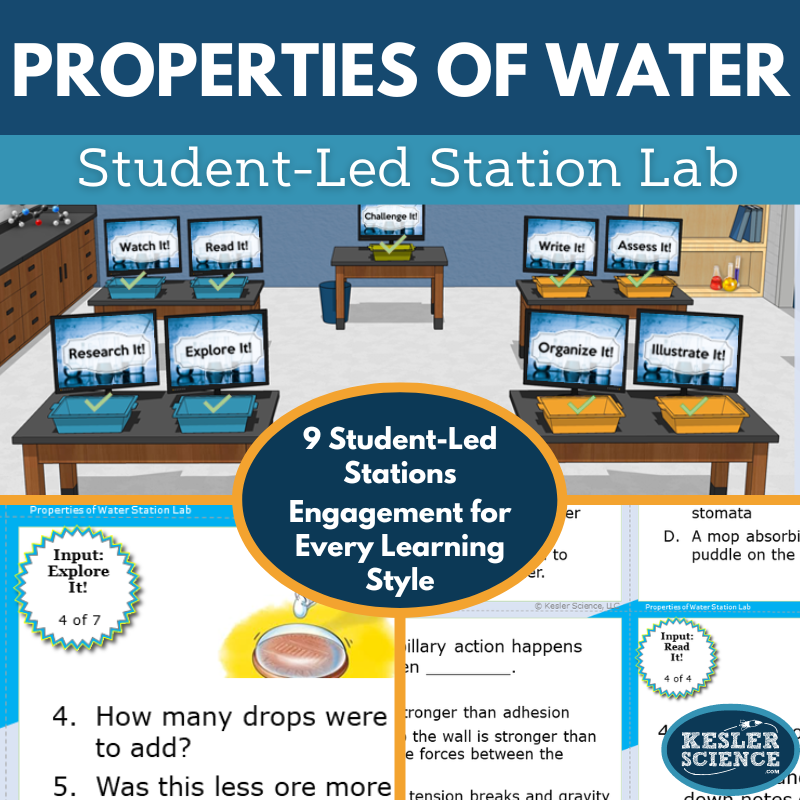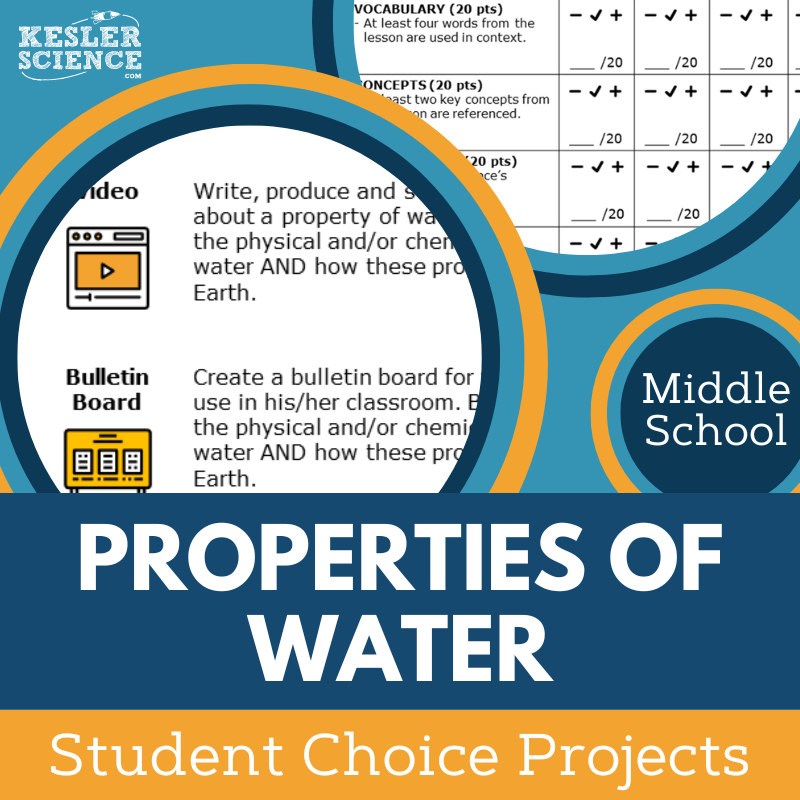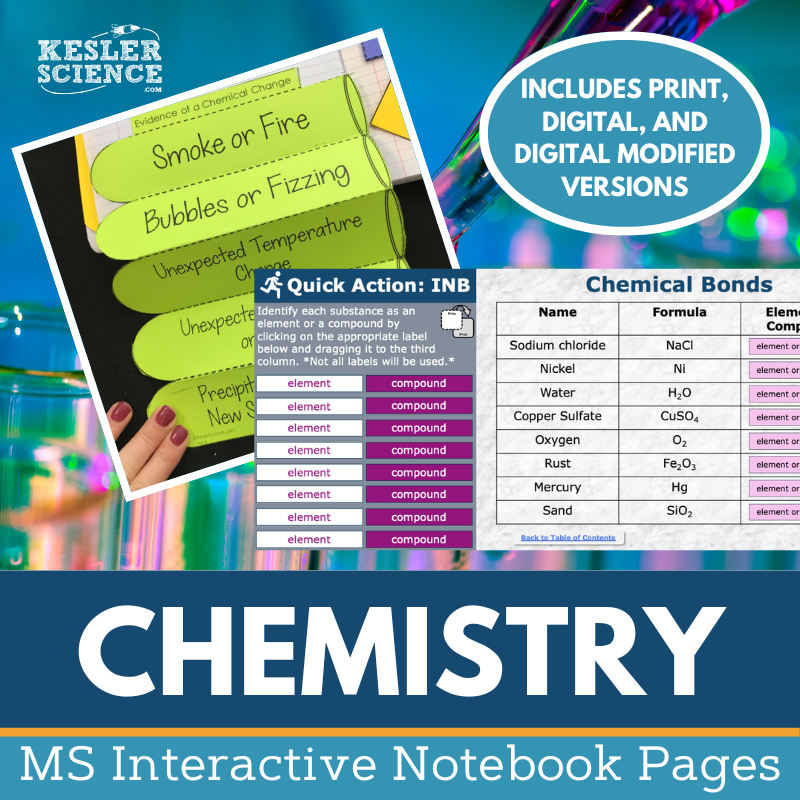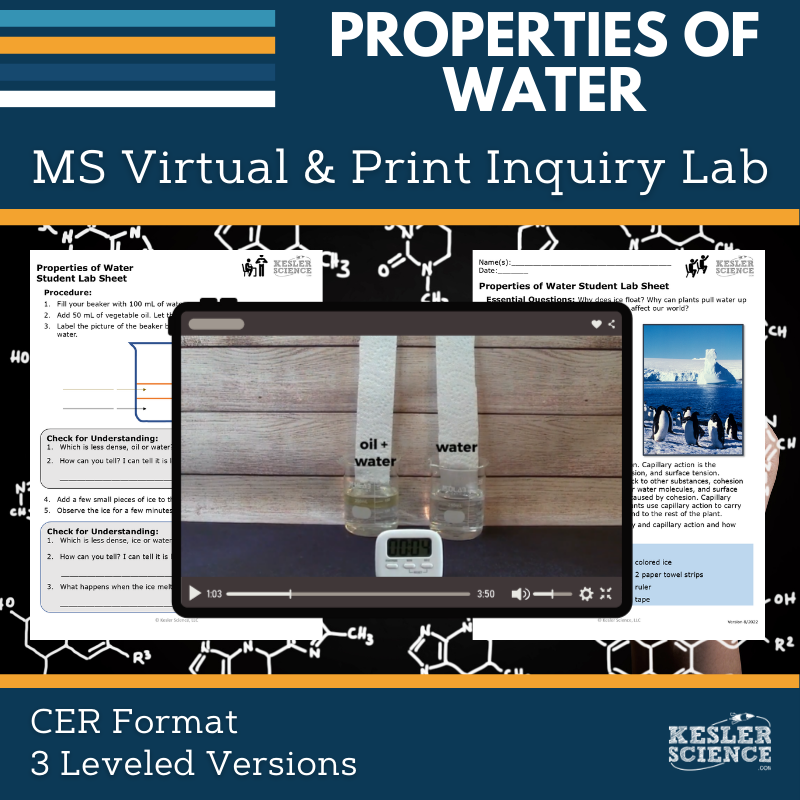Properties of Water Activities for Middle School Science
The Kesler Science Properties of Water resources offer a complete, multi-day lesson plan for teaching middle school students about the physical and chemical properties of water. The resources below will give students a comprehensive understanding of the properties of water. All of the following materials are also included in the Kesler Science Membership.
The Kesler Science Properties of Water Complete 5E Lesson provides a comprehensive, multi-day student-led experience on the properties of water. Designed for middle school students, it covers essential questions about the physical and chemical properties of water and their importance to Earth's systems. This resource offers differentiated materials, multimodal learning options, and flexible formats (printable and digital), making it suitable for various learning needs.
The lesson follows the 5E Model, including engagement with vocabulary and teacher activities, exploration through nine interactive, student-led stations, and explanation using editable PowerPoints and interactive notebooks. Students then extend their learning with elaboration activities like student-choice projects and are assessed with evaluation questions.
This lesson is perfect for in-person or virtual environments, with resources that ensure students can engage and learn regardless of their classroom setting.
The Kesler Science Properties of Water Complete 5E Lesson provides a comprehensive, multi-day student-led experience on the properties of water. Designed for middle school students, it covers essential questions about the physical and chemical properties of water and their importance to Earth's systems. This resource offers differentiated materials, multimodal learning options, and flexible formats (printable and digital), making it suitable for various learning needs.
The lesson follows the 5E Model, including engagement with vocabulary and teacher activities, exploration through nine interactive, student-led stations, and explanation using editable PowerPoints and interactive notebooks. Students then extend their learning with elaboration activities like student-choice projects and are assessed with evaluation questions.
This lesson is perfect for in-person or virtual environments, with resources that ensure students can engage and learn regardless of their classroom setting.
Engage your classroom with this student-led station lab focused on the properties of water. Aligned with middle school physical science standards, this modular activity allows students to explore hydrogen bonding and analyze key water properties through interactive, multimodal experiences. Designed for both in-person and virtual learning, it gives students the opportunity to direct their own learning while teachers take on a facilitative role.
The lab includes nine differentiated stations, each offering a unique way for students to process and apply information. Input stations such as Read It!, Watch It!, Research It!, and Explore It! introduce content through videos, readings, websites, and hands-on tasks. Output stations like Organize It!, Illustrate It!, Write It!, and Assess It! provide opportunities for students to demonstrate understanding through drawing, writing, and using manipulatives. A bonus Challenge It! station offers enrichment for early finishers.
Each station comes with task cards, resources, and signage to support independent or small group work. Materials are low-prep and can be used digitally or printed, with options for differentiated reading passages in English and Spanish. Whether used in a physical classroom or virtually, this lab promotes critical thinking, creativity, and active engagement.
Engage your classroom with this student-led station lab focused on the properties of water. Aligned with middle school physical science standards, this modular activity allows students to explore hydrogen bonding and analyze key water properties through interactive, multimodal experiences. Designed for both in-person and virtual learning, it gives students the opportunity to direct their own learning while teachers take on a facilitative role.
The lab includes nine differentiated stations, each offering a unique way for students to process and apply information. Input stations such as Read It!, Watch It!, Research It!, and Explore It! introduce content through videos, readings, websites, and hands-on tasks. Output stations like Organize It!, Illustrate It!, Write It!, and Assess It! provide opportunities for students to demonstrate understanding through drawing, writing, and using manipulatives. A bonus Challenge It! station offers enrichment for early finishers.
Each station comes with task cards, resources, and signage to support independent or small group work. Materials are low-prep and can be used digitally or printed, with options for differentiated reading passages in English and Spanish. Whether used in a physical classroom or virtually, this lab promotes critical thinking, creativity, and active engagement.
The Kesler Science Properties of Water Student Choice Projects offer middle school students a range of creative, student-led project options to demonstrate their understanding of water's properties. With six predefined projects and the option to design their own, students can select an output style that best suits their strengths.
The projects are flexible and come with an editable rubric that allows for teacher, peer, or self-assessment. Teachers can modify the rubric to suit specific grading needs, and the projects cater to various learning levels, offering support for students needing remediation and challenge for advanced learners.
Using basic classroom supplies like paper, markers, and scissors, or digital tools for projects, these student choice activities promote personalized learning and hands-on exploration. The variety of options ensures that all students can engage with the content in a meaningful way.
The Kesler Science Properties of Water Student Choice Projects offer middle school students a range of creative, student-led project options to demonstrate their understanding of water's properties. With six predefined projects and the option to design their own, students can select an output style that best suits their strengths.
The projects are flexible and come with an editable rubric that allows for teacher, peer, or self-assessment. Teachers can modify the rubric to suit specific grading needs, and the projects cater to various learning levels, offering support for students needing remediation and challenge for advanced learners.
Using basic classroom supplies like paper, markers, and scissors, or digital tools for projects, these student choice activities promote personalized learning and hands-on exploration. The variety of options ensures that all students can engage with the content in a meaningful way.
The Kesler Science Chemistry Interactive Notebook Bundle provides an engaging way for students to explore Chemistry concepts through interactive activities. Designed for both traditional classrooms and digital learning environments, this bundle includes print and digital versions, making it versatile for in-person, 1:1, or distance learning settings.
Topics covered include acids and bases, atoms, balancing chemical equations, chemical bonds, physical and chemical changes, the periodic table, properties of water, and more. The digital version features a unique PowerPoint interactive notebook that can be uploaded to platforms like Google Slides, MS Teams, or Schoology. It includes reflection pages, note-taking space, a teacher answer key, and a modified version for students needing accommodations.
The paper version offers blank templates for student interaction, pre-filled options for modified learners or absentees, and visual examples for guidance. This resource is ideal for fostering hands-on and digital engagement in middle school Chemistry.
The Kesler Science Chemistry Interactive Notebook Bundle provides an engaging way for students to explore Chemistry concepts through interactive activities. Designed for both traditional classrooms and digital learning environments, this bundle includes print and digital versions, making it versatile for in-person, 1:1, or distance learning settings.
Topics covered include acids and bases, atoms, balancing chemical equations, chemical bonds, physical and chemical changes, the periodic table, properties of water, and more. The digital version features a unique PowerPoint interactive notebook that can be uploaded to platforms like Google Slides, MS Teams, or Schoology. It includes reflection pages, note-taking space, a teacher answer key, and a modified version for students needing accommodations.
The paper version offers blank templates for student interaction, pre-filled options for modified learners or absentees, and visual examples for guidance. This resource is ideal for fostering hands-on and digital engagement in middle school Chemistry.
The Kesler Science Properties of Water Inquiry Lab aligns with the NGSS standards by allowing students to explore the concept of density through hands-on and digital investigations. Students will write and carry out a procedure to compare the densities of oil, water, and ice. This leads to meaningful discussions about why ice floats, how plants transport water, and how these properties affect life on Earth. Both versions of the lab include comprehension questions, Claim-Evidence-Reasoning (C.E.R.) prompts, and a reflection section to deepen student understanding.
Differentiated instruction is built into the resource with three full versions to support learners at varying levels. The Dependent version guides on-level learners through procedures with inquiry-based support, the Modified version is designed for students needing extra structure with sentence stems or multiple-choice questions, and the Independent version challenges advanced learners with minimal guidance and greater student autonomy.
The lab can be conducted in person using simple materials such as colored ice, water, paper towel strips, and vegetable oil, or completed virtually through an interactive PowerPoint file compatible with Google Slides. Teachers receive editable materials, answer keys, and teacher resource pages, making this a flexible and engaging tool for any classroom setting.
The Kesler Science Properties of Water Inquiry Lab aligns with the NGSS standards by allowing students to explore the concept of density through hands-on and digital investigations. Students will write and carry out a procedure to compare the densities of oil, water, and ice. This leads to meaningful discussions about why ice floats, how plants transport water, and how these properties affect life on Earth. Both versions of the lab include comprehension questions, Claim-Evidence-Reasoning (C.E.R.) prompts, and a reflection section to deepen student understanding.
Differentiated instruction is built into the resource with three full versions to support learners at varying levels. The Dependent version guides on-level learners through procedures with inquiry-based support, the Modified version is designed for students needing extra structure with sentence stems or multiple-choice questions, and the Independent version challenges advanced learners with minimal guidance and greater student autonomy.
The lab can be conducted in person using simple materials such as colored ice, water, paper towel strips, and vegetable oil, or completed virtually through an interactive PowerPoint file compatible with Google Slides. Teachers receive editable materials, answer keys, and teacher resource pages, making this a flexible and engaging tool for any classroom setting.
Year-Round Resources
These year-round activities will increase your students' understanding of many middle school science topics. All of these activities are also included in the Kesler Science Membership.
Visual Data & Graphing
You're not alone if your students struggle with understanding graphs, charts, and tables. It's a skill that takes an enormous amount of practice. This resource will help students build a strong foundation in analyzing data and creating their own data visualizations.
Bell Ringers and Warm-Ups
These middle school science bell ringers are an excellent way to engage your students as soon as they walk into your classroom. This comprehensive FULL YEAR resource includes everything you need to start off each science class with an interesting warm-up activity.
Review Board Games
Each game board has been carefully designed to keep students engaged. There are 10 different action spaces on each board and dozens of question cards. All of the actions are related to science concepts and keep the students motivated throughout the game.
Each game is ready to play. Simply print out the board and the cards and let the students enjoy reviewing nine different units.
Essential Questions
Below are the essential questions associated with the lessons and activities included in this unit. This topic is only one of more than 100 middle school science topics included in the Kesler Science Membership.
-
What are the physical and chemical properties of water?
-
How are the properties of water important to the planet’s dynamics?
Kesler Science Membership
Imagine never having to search for another middle school science lesson again. The membership gives you access to ALL of the Kesler Science products in one place (Yes, including everything above).
Say goodbye to long hours of lesson prep.

